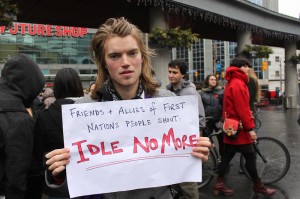Idle No More is an aboriginal rights movement that has taken off all over Canada. The Charlatan’s Véronique Hynes spoke to four people about what the movement means.
The Charlatan (TC): What is the purpose of Idle No More?
Tanya Kappo, Idle No More organizer, Edmonton:
“[It’s] a beautiful expression and resurgence of pride amongst aboriginal people. I think it’s not me who just sees and feels it. When I go to some of the flash mob round dances that have been happening here in Edmonton, and some of the images I see from different events across the country, I think Canadians are seeing that pride and resurgence for the first time in a long time. I think it’s really a beautiful thing in terms of finding some common ground to start having some kind of a dialogue for real change.”
Robert P. Shepherd, professor of public policy and administration, Carleton University:
“There have been two omnibus budget bills that have a number of aspects First Nations find unreasonable. From the decommission of lakes and rivers, to concerns [with] the environment, to changes to the Indian Act . . . these bills have been introduced without consulting First Nations whatsoever.”
“There is the National part of the movement, led by the Assembly of First Nations and other representative organizations. This has been going on for a while. It is concerned with renewing treaty development, and repealing the Indian Act.”
Then there’s the grassroots movement, seeing the world on an individual level . . . it aims to bring attention to things like the lack of housing, the lack of population graduating from First Nation schools, and the lack of safe water.”
TC: What does Idle No More mean to you?
Gabrielle Castilloux, president of First Peoples’ Council, third-year social work, Carleton University:
“Idle No More means to me that aboriginal voices are being raised and that the government must listen to us because Aboriginal Peoples and allies are standing up against the government on an international level about the respect for treaties and rights that have far too long been ignored.”
“We are planning a series of events from flash mobs to having info sessions, teach-ins, workshops, round dances and many events for students and the Idle No More movement on both campuses and in the community at large, as well as spearheading the Idle No More student movement across Canada.”

“Each person has their own definition of what Idle No More is, that’s what makes it grassroots. For me, the catalyst was Bill C-45 that is continuing to restrict and impeded on aboriginal treaty rights that have been established through the constitution.”
“The government has continually tried to avoid them. People of both aboriginal and non-aboriginal descent are sort of waking up and saying: ‘Hey, the government can’t continue to do this.’”
“When I have been to the demonstrations, they have done round dances, which is a very symbolic, beautiful thing where you hold hands with strangers and you move around in a circle while people are drumming and singing . . . It was just incredible. It was a lot of fun and very peaceful, but they got the message across.”





